#Laminated pouch material
Explore tagged Tumblr posts
Text
listen
we are a month into the school year and genuinely i am enjoying the kids, but the way i am OVER admin
so bc i teach 3 grades, they have me literally all over the place
i think i mentioned this b4
and i was like hey do yall realize you have me in 4-5 classrooms a day? like do yall understand that. and then they wanted me to switch with someone else (we have not switched, we literally just ignored that and stayed in our regular rooms)
so now im late to all my classes mostly and i just roll with it bc well. whos fault is that
you have me in the 320 hallway, and then downstairs to the 200s, and then back upstairs to the 300s
like please relax
and then when i was working with kids today, they came to ask me what strategies am i using in the room, if yall dont go on and just read the lesson plan-
ALSO lmaooo they switched this boy into one of the smaller classes, and didnt tell nobody
so EYE get to class like 3 minutes late, and they HE walked in 10 minutes late. but i didnt know he was supposed to be there so i was like BYE
BYE. if youre here bring me proof!
so the ap comes and shes like well admin has made a decision that this is his class
and i was like well nobody told me and he didnt even show up on time
and she was like well were not discussing that right now
girl??????????
if yall dont give me some damn paper and just leave me ALONE
#work things#where are the fucking laminating pouches#open the cage!!!#the cage is where our supplies are#you know they cleaned out the library last week#and they let our boys throw away literally THOUSANDS of dollars worth of books and materials#and then when ppl were like wtf where is the stuff#they SWORE they gave use a heads up#N O#i found out bc the ela head ran by during lunch like guys go steal supplies#and i did
3 notes
·
View notes
Text

Shrinath Rotopack Private Limited. aims to develop a customized flexible packaging company for the brands on a regular basis, training the manpower for better efficiency, constant check on customer preferences, improving customer service to gain a competitive edge, and providing an environmentally friendly production process. we can manufacture printed laminates, packaging materials, printed and plain pouches etc.
#packaging pouches#flexiblepackaging#flexiblelaminates#printedpackaging#printed laminates#packaging manufacturers#packaging materials company#plain pouches#printed pouches#food packaging pouches
1 note
·
View note
Text
SQUID INDUSTRIES NAUTILUS: AN IN-DEPTH REVIEW
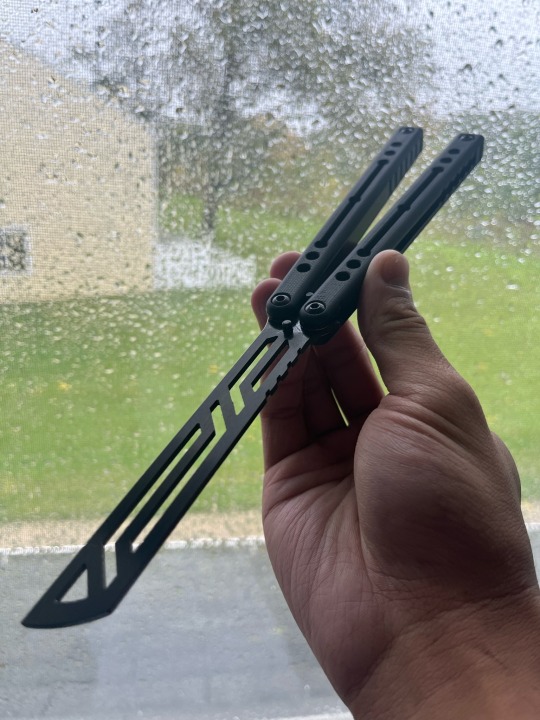
This is what is hopefully the start of various different balisong reviews that I get my hands on as I progress through the hobby of balisong flipping. While my preferences won't speak for the balisong community at large, I hope to be as objective as I can while still offering my thoughts and opinions where they're appropriate.
Tonight's review will be on the balisong pictured above: the Squid Industries Nautilus. Without further ado, let's jump into it.
TL;DR: The Good: Light, grippy, and flowy flipper that provides a unique experience few other balisongs can replicate. Has a lifetime warranty where Squid will fix any repairs or QC issues. The Bad: How it flips is not for everyone. Plagued with QC issues which shouldn't happen at its price—buying one new is a gamble, and Squid isn't perfect with warranty repairs. (Fair warning: there is a lot of jargon that can sound like word soup to anyone who doesn't flip. I'll try to explain it as best as I can and make another post detailing what everything means)
UNBOXING AND GENERAL INFO:
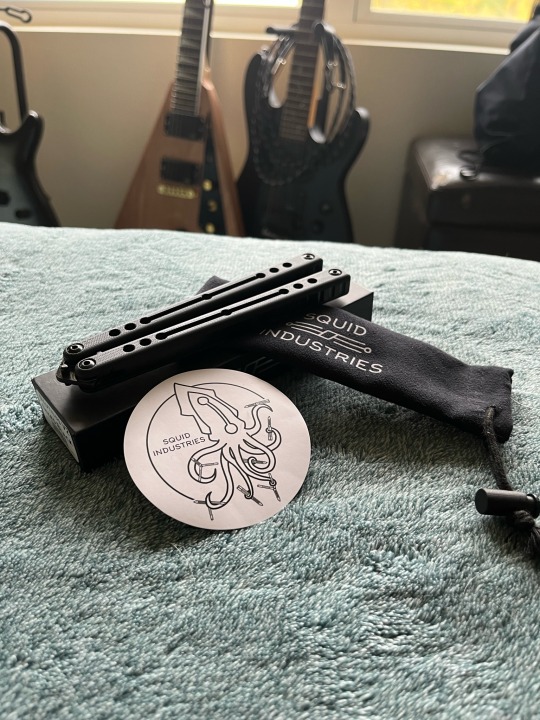
The Nautilus has a fairly standard unboxing experience. It comes in a simple but nice drawer-style box inside of a cloth pouch, and with it comes a set of replacement hardware (not pictured), a paper card with QR codes that lead to flipping tutorials and tuning guides, and a sticker. Simple and nothing amazing, but well-executed. As for the price, it isn't exactly cheap. The retail price of the Nautilus varies depending on what versions you go for. On Squid's site, the base Nautilus goes for $230 USD, and it only gets more expensive from there. The Winter Nautilus with white G10 scales is priced at $245 USD. The Inked Nautilus, which has a diamond-like carbon (DLC) coating on the blade, retails for $255 USD, while the Carbon Fiber Nautilus, which ditches G10 scales in favor of carbon fiber, retails for $295 USD.
Like all other Squid Industries balisongs, the Nautilus comes with a lifetime warranty—for something as minor as routine maintenance to something as major as bad quality control, it can be sent to Squid to fix whatever might be wrong with it. For the first 30 days, all the owner has to pay is for parts, and after that the owner has to pay for shipping and parts (although the latter might not apply in the case of QC issues).
DESIGN AND SPECS: Originally released on June 4, 2019, the Nautilus was released alongside the Krake Raken or Kraken, which I'll be using as a point of comparison for this design. Less experienced flippers often ask which of the two is "better", which is understandable given their similar prices, with the Kraken trainer starting at $215 USD, the Nautilus starting at $230 USD, and the Kraken live blade starting at $250 USD. However, as someone who owns both and flips both on a regular basis, they simply cannot be compared because of how different they are. The only thing the two have in common is the use of channel construction handles with 7075 aluminum as the handle material. Here are some photos with the two side-by-side: Below: Nautilus (black) and Kraken (purple)

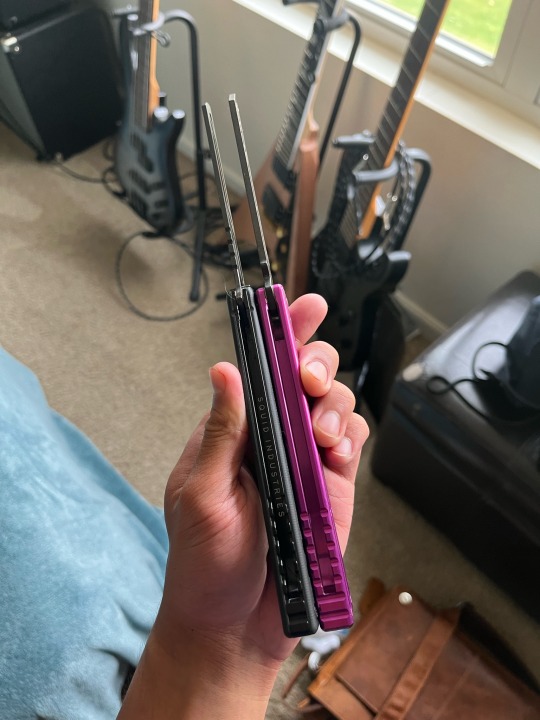
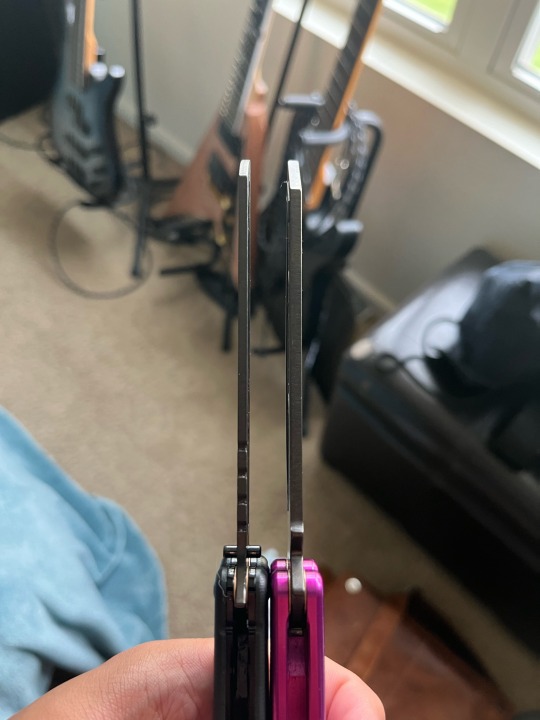
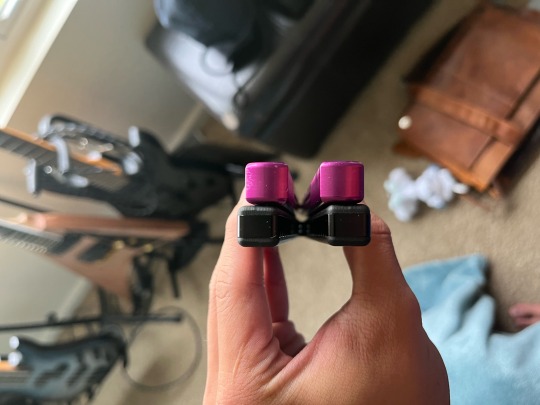
The Kraken is overall beefier with full aluminum handles and a thicker everything, lending it to weigh a normal 4.2 oz. Everything on the Nautilus is smaller and thinner, from the the use of G10 laminate scales for grip to the small size of the channel to the thickness of the handles and blade, lending it to be much lighter at 3.6 oz. These design choices make for a unique flipping experience that I'll expand on later.
TUNING AND QUALITY CONTROL: This is going to be a doozy for a multitude of reasons, and things might get confusing, but I'll try my best to explain everything: The Nautilus runs on a bushing pivot system, which means that as long as the bushings aren't smaller than the blade, the pivot screws can be fully cranked down without them locking up. On top of this, when bushings are tuned correctly, tap (where the blade is touching the inside of the handles), blade rub, and handle play (side-to-side slop) can be fully eliminated for a solid and premium feeling flipping experience. On paper. The reality is that the inherent design of the Nautilus is a huge double-edged sword. Remember how I mentioned that everything on the Nautilus is pretty thin and small? That leaves a whole lot less room for error when tuning. Its use of G10 doesn't help much, either, as the scales have to be aligned as close to perfect as possible in order to have a good tune. Squid Industries has taken a bit of a dip in quality control as of late, but the Nautilus has always been their biggest sore spot for QC because of its design, which many can attest to. Juice Tin, who I talked to on a somewhat regular basis, has had a QC nightmare—their Nautilus had blade rub out of the box alongside G10 scales that were unfinished at best and outright deformed at worst, and tap persisted even after changing the scales and sending it in for warranty (both of our Nauts also happened to be QC'd by the same person, and I had issues as well). Yet another victim of the Naut's bad QC was CamaroEE, who held the Nautilus as one of his dream trainers at the time but was plagued with tap and blade rub that Squid couldn't fix when it was sent to them for warranty repairs, leading him to ultimately sell it and call it "the grayest balisong" in his review for it. I have also had QC issues on my end, albeit to not as much of an extent as others did. My Nautilus came straight out of the box with tap and blade rub, and it took an involved teardown and retuning that lasted over 2 hours to get the issue fixed. As of the time of writing this review, the tap is gone, and while it has a bit more play than I'm normally comfortable with, it's a lot better than before. Here's the thing: I love fixing and working on my own stuff, and I had no problems with fixing the issues my Nautilus had out of the box. The problem lies within the facts that: - I had to do it at all - I expected and prepared for it - I had heard about it from at least half the people I talked to who already owned one These would be at least somewhat excusable if the Nautilus was cheap, but with a starting price tag of $230 USD, I am giving Squid far less leeway here. Someone without the know-how, finally happy they have the money to buy something nice, could very easily buy this without doing the proper research, only to get slapped in the face with issues that many balisongs half its price don't have.
But because I'm no Negative Nancy, enough about my QC tirade. Because it flips very good. FLIPPING:
God damn, this is a fun flipper. The Nautilus has a heavy handle bias, meaning that if you were to balance it on your finger, the point of balance would be about halfway down the handles. Remember how I mentioned that it weighs 3.6 oz? For anyone not familiar with balisong flipping, that is absurdly light for a metal balisong since most balisongs on the market range from 4–4.5 oz, and it shows in how it behaves. The light weight and handle bias make for an almost floaty experience that's difficult to put into words. Rollovers and chaplins are very smooth and take no effort at all. The handle bias means that fans aren't nearly as good as it could be, but the balisong can absolutely still fan—choker fans and Z-chokers are easy to land, and ladders take much less finger strength than on most other balisongs. To top it all off, the G10 scales provide an absurd amount of grip, and I've yet to have it slip out of my hands during flipping. This sort of flipping experience tells me that the Nautilus was built with uncompromising pedal-to-the-medal flipping in mind, and with the people out there who flip the absolute balls off of it, I can't be completely wrong. With nearly everything being so effortless and smooth on the Nautilus, could it be the best flipper in its price range? Well, no. This hobby's so damn subjective that there really is no "best" balisong. The Nautilus has certain things about it that people could very easily dislike, the biggest of which is, funnily enough, the weight. As a small person with grubby little raccoon hands, the light weight and thin handles are perfect for me, but there are people out there who prefer heavier balisongs—one person I've talked to even likened it to a toy with how unsubstantial it felt in the hand for them. The other point of divide is the use of G10. The thing about G10 is that even when it's well-finished, it has a very chalky feel to it that most people don't like if it isn't given some oil (mink oil works great). Many times it can even feel a bit cheap even though it's quite the opposite, both to buy and to work with. Not to mention the balance; the handle bias on it is very noticeable, and there are plenty of people who don't like that much handle bias—hell, if it were heavier, I wouldn't have liked it as much. So, because of that, while it is my favorite balisong in my collection, it isn't a balisong that's as universally liked as much as something like a Kraken is. FINAL THOUGHTS: To close off, while plagued with hit-or-miss QC, the Squid Industries Nautilus is a light, flowy balisong trainer that offers a fun flipping experience that few other balisongs can offer. I want to recommend this balisong so badly because of how much fun I've had flipping it, but because Squid doesn't know how to QC them, I just can't unless you're not one to really care about tolerances. However, I do think you should at least give it a try because it is genuinely one of the most unique flipping experiences out here. If you're interested in buying a Nautilus, it can be found here.
#blog#review#hobby#skill hobby#skill toy#knife#balisong#butterfly knife#butterfly knives#balisong flipping#mfw a $230+ skill toy has qc issues
8 notes
·
View notes
Text
Transform Packaging Efficiency with Film Lamination Adhesives

In today's fast-paced world, efficiency and sustainability are more important than ever. For film manufacturers, print industry professionals, and product packaging designers, finding ways to reduce waste while improving efficiency is crucial. Enter film lamination adhesives—a game-changing solution that can transform your packaging processes. This blog post explores how film lamination adhesives can help you achieve these goals, making your packaging not just better but also greener.
Understanding Film Lamination Adhesives
Film lamination adhesives are specialized compounds designed to bond layers of film together, creating a single, cohesive material. Used extensively in packaging, these adhesives offer numerous benefits, including enhanced durability and improved barrier properties.
Why Use Film Lamination Adhesives?
Film lamination adhesives are essential for creating multi-layered packaging that protects products effectively. They provide a strong bond between different types of films, ensuring that the final product is both durable and functional.
Types of Film Lamination Adhesives
There are several types of film lamination adhesives available, each designed for specific applications. These include water-based, solvent-based, and solvent-free adhesives. Each type has its own set of advantages, making them suitable for various packaging needs.
Applications in Packaging
Film lamination adhesives are used in a wide range of packaging applications. From seed and pesticide packaging to dairy products and vacuum pouches, these adhesives offer versatile solutions for various industries.
Benefits of Film Lamination Adhesives
Using film lamination adhesives in your packaging processes can significantly reduce waste and improve efficiency. Here are some key benefits:
Enhanced Durability
One of the primary advantages of film lamination adhesives is their ability to create highly durable packaging. This means your products are better protected, reducing the risk of damage during transit.
Improved Barrier Properties
Film lamination adhesives help enhance the barrier properties of packaging, making it more resistant to moisture, oxygen, and other external factors. This is particularly important for products like dairy and vacuum-sealed items.
Versatility
Film lamination adhesives are incredibly versatile, making them suitable for a wide range of applications. Whether you're packaging seeds, pesticides, or consumer goods, these adhesives can meet your needs.
Improving Efficiency in Packaging
Efficiency is key to staying competitive in the packaging industry. Film lamination adhesives can streamline your processes, making them more efficient and cost-effective.
Faster Production Times
Film lamination adhesives can significantly speed up production times. By creating strong bonds quickly, they allow for faster assembly of multi-layered packaging, increasing your overall output.
Reduced Downtime
Using high-quality film lamination adhesives can reduce downtime caused by equipment malfunctions or material failures. This ensures a smoother production process and higher efficiency.
Cost Savings
By minimizing waste and improving production efficiency, film lamination adhesives can lead to significant cost savings. This makes them a smart investment for any packaging operation.
The Future of Packaging with Film Lamination Adhesives
The packaging industry is constantly evolving, and film lamination adhesives are at the forefront of this evolution. By adopting these advanced adhesives, you can stay ahead of the curve and ensure your packaging processes are both efficient and sustainable.
Innovations on the Horizon
Ongoing research and development in film lamination adhesives promise even more exciting innovations in the future. Stay tuned for new products and technologies that will further enhance your packaging capabilities.
Commitment to Sustainability
At [Your Company Name], we're committed to sustainability. Our film lamination adhesives are designed to minimize environmental impact while delivering superior performance. Join us in our mission to create a better, more sustainable future.
Taking the Next Step
Ready to revolutionize your packaging processes? Contact us today to learn more about our film lamination adhesives and how they can benefit your business. Our team of experts is here to help you find the perfect solution for your needs.
2 notes
·
View notes
Text
Accessory Pouch w T-bottom
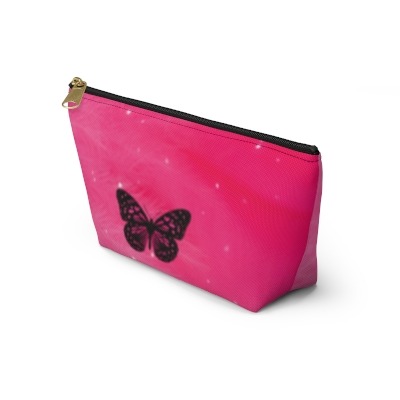


USD 10.87 Add to Cart About product Small Length, in 8.66 Width, in 2.36 Height, in 4.72 Our T-bottom bags range from small to large and can be used for just about anything. They make excellent pencil cases and cosmetic travel bags. They are constructed from a durable material with a zipper closure. .: 100% Polyester .: With laminated non-woven inside .: Many sizes .: Note! Size tolerance 0.375" (0.9 cm)) .: NB! For best printing results, avoid complicated designs. Due to printing technology, small texts and drawings with a lot of detail may be blurred. .: Assembled in the USA from globally sourced parts.
Access link:https://my-new-store-d621cbc36d.printify.me/product/801836/accessory-pouch-w-t-bottom
2 notes
·
View notes
Text

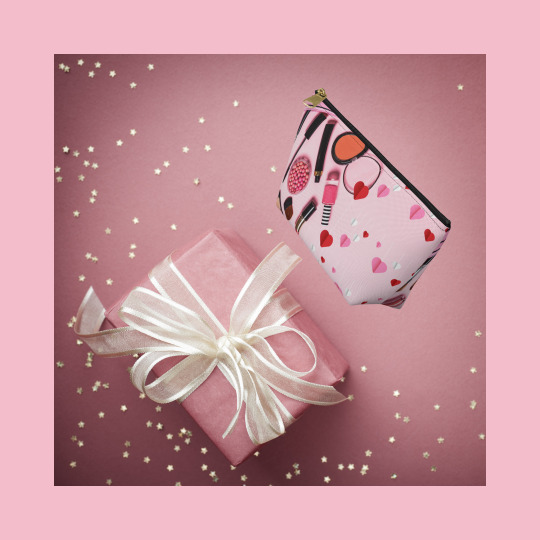
Best Friend Gift- Stylish Practical Bags for Women Patterns & Designs -Tote Set-Makeup Bag, Cosmetic Bag, Canvas Bag
An accessory pouch with a T-bottom is a small bag typically used for storing and organizing small items such as makeup, toiletries, or stationery. The "T-bottom" refers to the shape of the bottom of the pouch, which has a flat base with two triangular sides that create a wider opening at the top of the pouch. This design allows the pouch to stand up on its own and makes it easier to access the contents inside.
The accessory pouch with a T-bottom can come in a variety of materials such as cotton, canvas, or nylon, and may have a zipper or drawstring closure. They are often compact and portable, making them convenient for travel or everyday use. Additionally, some accessory pouches with a T-bottom may have additional features such as pockets or compartments for added organization.
Our t-bottom pouches vary from small to large and can be used for pretty much anything. They make excellent pencil cases and cosmetic travel bags. They are constructed from a durable material with a zipper closure. .: 100% Polyester .: With non-woven laminate inside .: Multiple sizes .: NB! Size tolerance 0.375" (0.9 cm)) .: NB! For better printing results, please avoid intricate designs. Due to the print technology, small texts and high-detail designs may turn out blurry .: Assembled in the USA from globally sourced parts
#birthday gift#etsy gifts#totebag#accessories#fashion accessory#gift for women#giftideas#giftformom#giftbox
4 notes
·
View notes
Text

Carol of the spells
It’s tiiiiiiiiime! *insert high pitched Mariah Carey noise*
As you may have heard I’m doing this little Christmas project over on my Tiktok. Starting December 1st, there will be a little video each day with a Harry Potter or Hogwarts themed craft idea.
On this platform, I’ll be posting templates I made for the projects and some printables.
I’ll try to link everything here so you can refer to this post when you’re looking for something :)
Also, there’s a list of materials and tools I used for the projects. Please note that I am not sponsored by anyone neither do I advertise these things. I’m just a girl with an unhealthy amount of crafting supplies.
Check out the post below for details! Happy crafting and a wonderful Christmas time to y’all <3

Templates and printables:
(There won’t be a file for every project)
The links to the files will appear here!
Materials & tools:
Hotglue & multipurpose glue
Inkjet printer
For cutting: scissors, guillotine, boxcutter, ruler
Laminator and laminating pouches
My cricut maker including materials like vinyl or iron-on foil
Different pens (sharpies, pens for writing on porcelain, watercolour pens)
Different kinds of fabric
#hogwartschristmas#hogwartsholidaycrafts#harrypotteradventcalendar#wizardingworldchristmas#christmasathogwarts#merryandmagical#holidaydiys#christmascrafts#festivefun#diyhogwarts#craftingwizardry#spellbindingdiy#wizardingdiy#diymagic#wizardingworlddiy#magicaldiy#potterheadcrafts#diyforpotterheads#harrypotterdiy#diycrafts#handmadeprojects#craftyideas#craftinginspiration#diyprojects#doityourself#diyideas#diyinspiration#diytutorials#diyhacks#hogwartslegacy
0 notes
Text
Pressure Sensitive Labels

Pressure Sensitive Labels
Pressure Sensitive Labels are pre gummed labels available in roll form to be used in a label applicator machine or applied by hand. There are many kinds of pressure sensitive labels such as paper, film, transparent (no look), speciality materials depending on the product and industry. Pressure Sensitive label is one of the most common product decorations for FMCG, Beverages, Spirits and Pharmaceutical industries. Pressure Sensitive labels can be applied on all types of plastic and metal containers, PET and Glass bottles, paper and laminated pouches. Roll Form Pressure Sensitive labels are manufactured in Flexo printing machines and for short quantities they are produced in Digital printing machines. Various embellishments such as spot coating, Hot foil, Embossing and thermo-reactive print are possible on pressure sensitive labels.
Types
Foil labels
No- look labels
Metallic labels
Color Changing labels
Double Side printed labels

Benefits of
Pressure Sensitive Labels
Highly decorative graphics are possible on these labels with multiple embellishments.
Clean finish of the applied labels on the bottle or jar. There are no excess gum leaking from poor application and the alignment of label to the bottle is straight on all the bottles.
No need to invest in complicated equipment to apply labels
No skilled operators needed to apply these labels and savings in man power costs involved in label application quality checks and correction
Numerous substrates options such as paper, plastic and clear films are available in these labels.
0 notes
Text
Flexible Packaging Market Size, Share, Growth Analysis And Forecast Report 2030
The global flexible packaging market size is expected to reach USD 373.34 billion by 2030, according to a new report by Grand View Research, Inc., expanding at a CAGR of 4.8% from 2024 to 2030. This market growth is owing to the growing importance of increasing food shelf life and growing adoption of sustainable and cost-effective packaging by end-users.
The shelf life of food products depends on factors such as storage conditions, packaging material, and exposure to microorganisms, oxygen, light, and moisture. The flexible packaging consists of plastic films with high barrier properties. The high-barrier properties efficiently block the transmission of moisture, light, and oxygen from contacting sensitive foods. Furthermore, the reseal closure products featured flexible packaging that allow users to securely close the bags or pouches, ensuring the freshness of the packaged food products over several uses.
The industry players are adopting several strategies including partnerships, expansions, mergers & acquisitions, joint ventures, new product launches, and partnership agreements to increase the customer base and individual market share. For instance, in May 2023, Amcor plc inked an agreement to acquire New Zealand-based automated protein packaging machines manufacturer, Moda Systems. This acquisition is expected to provide Amcor plc with a new option related to equipment in automated protein products packaging, making it the only flexible packaging manufacturer to own high-speed rotary equipment for packaging fresh meat.
Gather more insights about the market drivers, restrains and growth of the Global Flexible Packaging Market
Flexible Packaging Market Report Highlights
The rapid growth of e-commerce sector globally creates opportunities for flexible packaging manufacturers to cater to the specific needs of online retail businesses. Companies that develop packaging solutions to protect products during transit, reduce damage, and improve unboxing experiences can gain a competitive advantage in the e-commerce market
The growing number of medical device manufacturers and ongoing research on new packaging materials is driving the market for medical flexible packaging. The strong healthcare infrastructure coupled with growing healthcare spending in the public sector is expected to have a positive impact on market demand
The pouches segment is expected to grow at a CAGR of 5.2% over the forecast period 2024-2030. This is owing to the pouches being resealable and a cost-effective alternative to metal, cardboard, and glass containers for packaging solutions
Food & beverage was the largest application segment, accounting for 55.9% of global volume share in 2023. Growing demand for packaged foods, including ready-to-eat meals, frozen meals, snack foods, and cake mixes, is expected to force flexible packaging manufacturers to increase production capacity, thus augmenting market for flexible packaging demand over the forecast period
Asia Pacific recorded a higher market share in 2023 owing to factors such as rising population, rising income levels, and changing lifestyles are expected to drive consumption of the packaged food cosmetics, and pharmaceutical products resulting in increased demand for flexible packaging solutions
Several key companies are collaborating to strengthen their market positions in the flexible packaging industry. For instance, in June 2023, Coveris acquired Poland-based D.K. LAMIN, a manufacturer of flexible packaging laminated films and converted products. With an emphasis on value-added medical packaging, home and personal care food, and pet food, D.K. LAMIN's experience and product offerings integrate with Coveris' existing product portfolio, particularly complementing its pet food growth goal
Browse through Grand View Research's Plastics, Polymers & Resins Industry Research Reports.
Cross-linked Polyethylene Market: The global cross-linked polyethylene market size was valued at USD 8.0 billion in 2023 and is projected to grow at a CAGR of 6.9% from 2024 to 2030.
Poly Alpha Olefin Market: The global poly alpha olefin market size was valued at USD 1.48 billion in 2023 and is projected to grow at a CAGR of 2.8% from 2024 to 2030.
Flexible Packaging Market Segmentation
Grand View Research has segmented the global flexible packaging market report based on material, product, application, and region
Flexible Packaging Material Outlook (Volume, Kilotons; Revenue, USD Million, 2018 - 2030)
Plastics
Polyethylene (PE)
Polypropylene (PP)
Polyamide (PA)
Polyvinyl Chloride (PVC)
Polystyrene (PS)
Others
Paper
Metal
Bioplastics
Flexible Packaging Product Outlook (Volume, Kilotons; Revenue, USD Million, 2018 - 2030)
Bags
Pouches
Retort Pouches
Refill Pouches
Rollstock
Films & Wraps
Others
Flexible Packaging Application Outlook (Volume, Kilotons; Revenue, USD Million, 2018 - 2030)
Food
Beverages
Pharmaceutical & Healthcare
Personal Care & Cosmetics
Others
Flexible Packaging Regional Outlook (Volume, Kilotons; Revenue, USD Million, 2018 - 2030)
North America
Europe
Asia Pacific
Central & South America
Middle East & Africa
Order a free sample PDF of the Flexible Packaging Market Intelligence Study, published by Grand View Research.
0 notes
Text
Flexible Packaging Market Size, Share, Growth, Analysis Forecast to 2030
The global flexible packaging market size is expected to reach USD 373.34 billion by 2030, according to a new report by Grand View Research, Inc., expanding at a CAGR of 4.8% from 2024 to 2030. This market growth is owing to the growing importance of increasing food shelf life and growing adoption of sustainable and cost-effective packaging by end-users.
The shelf life of food products depends on factors such as storage conditions, packaging material, and exposure to microorganisms, oxygen, light, and moisture. The flexible packaging consists of plastic films with high barrier properties. The high-barrier properties efficiently block the transmission of moisture, light, and oxygen from contacting sensitive foods. Furthermore, the reseal closure products featured flexible packaging that allow users to securely close the bags or pouches, ensuring the freshness of the packaged food products over several uses.
The industry players are adopting several strategies including partnerships, expansions, mergers & acquisitions, joint ventures, new product launches, and partnership agreements to increase the customer base and individual market share. For instance, in May 2023, Amcor plc inked an agreement to acquire New Zealand-based automated protein packaging machines manufacturer, Moda Systems. This acquisition is expected to provide Amcor plc with a new option related to equipment in automated protein products packaging, making it the only flexible packaging manufacturer to own high-speed rotary equipment for packaging fresh meat.
Gather more insights about the market drivers, restrains and growth of the Global Flexible Packaging Market
Flexible Packaging Market Report Highlights
The rapid growth of e-commerce sector globally creates opportunities for flexible packaging manufacturers to cater to the specific needs of online retail businesses. Companies that develop packaging solutions to protect products during transit, reduce damage, and improve unboxing experiences can gain a competitive advantage in the e-commerce market
The growing number of medical device manufacturers and ongoing research on new packaging materials is driving the market for medical flexible packaging. The strong healthcare infrastructure coupled with growing healthcare spending in the public sector is expected to have a positive impact on market demand
The pouches segment is expected to grow at a CAGR of 5.2% over the forecast period 2024-2030. This is owing to the pouches being resealable and a cost-effective alternative to metal, cardboard, and glass containers for packaging solutions
Food & beverage was the largest application segment, accounting for 55.9% of global volume share in 2023. Growing demand for packaged foods, including ready-to-eat meals, frozen meals, snack foods, and cake mixes, is expected to force flexible packaging manufacturers to increase production capacity, thus augmenting market for flexible packaging demand over the forecast period
Asia Pacific recorded a higher market share in 2023 owing to factors such as rising population, rising income levels, and changing lifestyles are expected to drive consumption of the packaged food cosmetics, and pharmaceutical products resulting in increased demand for flexible packaging solutions
Several key companies are collaborating to strengthen their market positions in the flexible packaging industry. For instance, in June 2023, Coveris acquired Poland-based D.K. LAMIN, a manufacturer of flexible packaging laminated films and converted products. With an emphasis on value-added medical packaging, home and personal care food, and pet food, D.K. LAMIN's experience and product offerings integrate with Coveris' existing product portfolio, particularly complementing its pet food growth goal
Browse through Grand View Research's Plastics, Polymers & Resins Industry Research Reports.
Cross-linked Polyethylene Market: The global cross-linked polyethylene market size was valued at USD 8.0 billion in 2023 and is projected to grow at a CAGR of 6.9% from 2024 to 2030.
Poly Alpha Olefin Market: The global poly alpha olefin market size was valued at USD 1.48 billion in 2023 and is projected to grow at a CAGR of 2.8% from 2024 to 2030.
Flexible Packaging Market Segmentation
Grand View Research has segmented the global flexible packaging market report based on material, product, application, and region
Flexible Packaging Material Outlook (Volume, Kilotons; Revenue, USD Million, 2018 - 2030)
Plastics
Polyethylene (PE)
Polypropylene (PP)
Polyamide (PA)
Polyvinyl Chloride (PVC)
Polystyrene (PS)
Others
Paper
Metal
Bioplastics
Flexible Packaging Product Outlook (Volume, Kilotons; Revenue, USD Million, 2018 - 2030)
Bags
Pouches
Retort Pouches
Refill Pouches
Rollstock
Films & Wraps
Others
Flexible Packaging Application Outlook (Volume, Kilotons; Revenue, USD Million, 2018 - 2030)
Food
Beverages
Pharmaceutical & Healthcare
Personal Care & Cosmetics
Others
Flexible Packaging Regional Outlook (Volume, Kilotons; Revenue, USD Million, 2018 - 2030)
North America
Europe
Asia Pacific
Central & South America
Middle East & Africa
Order a free sample PDF of the Flexible Packaging Market Intelligence Study, published by Grand View Research.
0 notes
Text
Heat Seal Tester
The Heat Seal Tester from Perfect Group is an advanced instrument to measure how well different packing materials seal. It ensures safe and airtight packaging by measuring the heat sealing qualities of films, pouches, and laminates. It is a crucial instrument for sectors including food, pharmaceuticals, and packaging since it stops leaks and preserves product quality. The Heat Seal Tester increases the productivity of production, lowers waste, and promotes adherence to quality standards with its dependable results and easy-to-use interface. Use Perfect Group to improve your packaging performance.
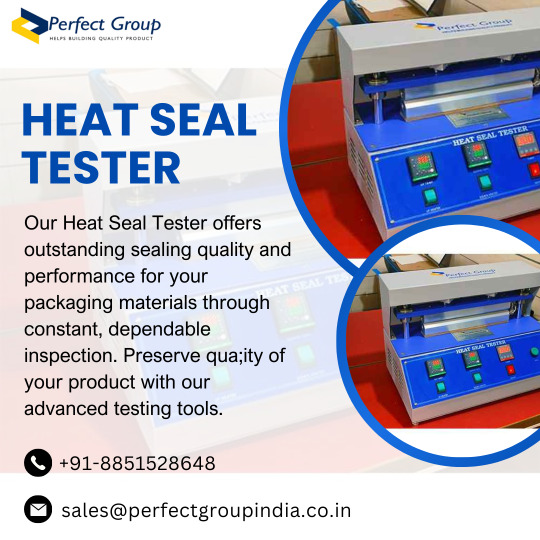
0 notes
Text
Why Choose Gravure Printing Machines for High-Quality Output
Gravure printing is often referred to as the Rolls Royce of printing. Its reach, sharp images, and brilliant colors combine to make it perfect for any high capacity work. As one of the prominent suppliers, UV Graphic offers gravure printing machineries suited for sectors such as packaging, publication and decorative printing among others. These machines perform excellently, allow faster speeds without any drop in quality.

Gravure printing machines are most appreciated for their capability of printing on surfaces with intricate designs over a wide range of materials, including plastic, paper and foil. Engraved cylinders used in the technology ensures that consistent quality is maintained even with long run jobs. UV Graphic implant eyebrows machines are the latest technology with auto controls, low energy use, fast transition reconfiguration, therefore adaptable to the current printing requirements.
Such kind of machines are widely used in the packing sector for making flexible pouches, wrappers and carton boxes. Also in publishing in case of printing magazines and catalogs and in the decorative printing of wallpapers and laminates. With the introduction of the latest technology, UV Graphic makes ensures the efficient production process without compromising on the quality through the global standards.
Riding on guidelines of innovation and environmental protection, UV Graphic’s gravure printing machines help companies retain excellent performance while conserving resources making it impossible for them not to compete in the printing business.
0 notes
Text
Guide to Food Packaging Materials in India
In recent years, the food industry in India has seen notable growth. With this rise, the demand for safe food packaging has become more important. Food packaging is about ensuring safe transport, appealing design, and environmental responsibility. Read this blog until the end to learn about some of the primary food packaging materials and provide helpful insights for selecting the right food packaging design for your products.

Why is Food Packaging Important?
Packaging is fundamental in delivering fresh, safe, and visually appealing products to customers. Good packaging keeps food protected from contamination and extends its shelf life. It also helps with the branding and marketing of a product, as packaging design often draws the customer’s eye. In India, where the climate varies across regions, food packaging materials must be durable, moisture-resistant, and budget-friendly.
5 Common Food Packaging Materials
Different types of materials are used to package food in India. Each type of packaging material offers distinct benefits, and understanding these will help you make better choices for your packaging needs.
Plastic is one of India’s most widely used materials for food packaging. It is versatile, lightweight, and offers excellent moisture resistance, making it ideal for products that need to stay fresh for longer. Many food packaging suppliers use plastic due to its low cost and ability to be moulded into different shapes and sizes. Plastics like PET, HDPE, and LDPE are common in food packaging design. However, with the rise of environmental awareness, many businesses seek more sustainable options.
2. Glass is a robust, reusable packaging material famous for packaging sauces, jams, and pickles. It keeps food items fresh without reacting chemically, making it a safe option. Although glass is heavier than other materials, its durability and clarity make it a preferred choice for premium food brands. Many people also see glass as a more sustainable packaging material, as it is 100% recyclable.
3. Paper and paperboard are commonly used for packaging dry foods like biscuits, cereals, and snack bars. They are lightweight, affordable, and easily recyclable, making them popular in sustainable packaging. Paperboard is also customisable, so brands often use it to design attractive packaging.
4. Flexible packaging is an umbrella term for materials like pouches, bags, and wraps, often made from plastic, paper, or aluminium combinations. It is ideal for products like chips, chocolates, and powdered items. Flexible packaging allows food packaging suppliers to create unique shapes and sizes, helping brands stand out.
5. Aluminium foil is popular for packaging food items like snacks, ready-to-eat meals, and even dairy products. It protects food from light, moisture, and air, keeping it fresh for longer. Aluminium foil can be used as a standalone material or laminated with other materials for extra durability. This material is lightweight and easy to recycle, adding to its appeal in sustainable packaging.
Sustainable Packaging Options in India
Consumers have become more conscious about the environment. Many brands are now seeking sustainable alternatives to traditional materials. Sustainable packaging is using materials that have less impact on the environment, either biodegradable or recyclable. Here are some popular packaging sustainable options.
Biodegradable Plastics
Biodegradable plastics break down naturally, unlike traditional plastics. They are made from plant-based materials like corn starch, which makes them a good choice for packaging food while minimising waste. Many food packaging suppliers offer these alternatives as they align with global environmental standards.
Compostable Packaging
Compostable materials go further than biodegradable materials, breaking down into natural elements that nourish the soil. Materials like bagasse (a by-product of sugarcane) and other plant fibres are gaining popularity for packaging food sustainably. Compostable packaging is ideal for single-use products, offering an eco-friendly solution.
Recycled Paper and Cardboard
Recycled paper is another sustainable option widely used in India. Using recycled paper reduces the demand for virgin materials, helping conserve resources. This material is best suited for dry goods and products that don’t require much moisture protection.
Conclusion
Partnering with a reliable food packaging supplier in India is important for quality and consistency in your packaging. Look for suppliers who can meet your specific needs and provide high-quality materials. Finding a supplier who offers sustainable options is also helpful, especially if your brand wants to reduce its environmental footprint. A good supplier like Global Parachem can help you create a packaging product that aligns with your brand values and appeals to your target audience.
0 notes
Text
Shaping the Future of Lithium-ion Batteries: Cylindrical, Prismatic, or Pouch?

In the relentless pursuit of advancing battery technology, the shape and structure of lithium-ion batteries play a pivotal role. These batteries come in three primary forms, each with unique characteristics, advantages, and drawbacks.
Here we will discuss Lithium-ion Batteries: Cylindrical, Prismatic, or Pouch. Notably, in recent years, the market has witnessed a significant surge in the popularity of pouch batteries, hinting at a potential market takeover, with experts predicting that the market share of pouch batteries will soon surpass 50%.
The Triad of Lithium-ion Batteries

Cylindrical Batteries: Proven and Prolific
Cylindrical lithium-ion batteries come in various models, such as 14650, 17490, 18650, 2170, and 26500. These batteries have a well-established production process, offering low PACK costs and high yield, ensuring consistency across battery packs.
With its ample heat dissipation area, the cylindrical form outperforms prismatic and pouch batteries in terms of thermal management. The mature production of these batteries is seen in countries like China, Japan, South Korea, and the United States.
While cylindrical batteries have gained acclaim for their reliability, they tend to be heavier, less space-efficient and offer relatively low energy density at the pack level.
With the growing demands of the electric vehicle market, there's a push to increase the size of cylindrical batteries, aiming to extract more battery capacity.
Prismatic Batteries: Bigger and Bolder
Prismatic batteries are encased in materials like aluminum alloy, and stainless steel, and are assembled through winding or lamination.
They excel in safety and flexibility, and their design allows for easy assembly of high-capacity batteries.

Prismatic batteries boast higher pack density but require improved heat dissipation due to the smaller gap between cells.
The transition from steel shells to aluminum shells has gained momentum, given their lightweight, safety, and performance advantages. These batteries find extensive application in electric vehicles and are renowned for their robustness.
Pouch Batteries: Market Dominance on the Rise
Pouch batteries maintain traditional cathode and anode materials but differ in their flexible packaging material, typically an aluminium-plastic composite film.
This unique packaging material accounts for their lighter weight, making them 40% lighter than steel-shell batteries and 20% lighter than aluminium-shell batteries of the same capacity.

The flexible design of pouch batteries allows for variable shapes and thinness, facilitating the development of new battery models tailored to customer needs.
However, pouch batteries grapple with issues of poor consistency, higher production costs, and susceptibility to leakage, challenges that can be mitigated through scale and quality improvement.
Pouch batteries find extensive use in consumer electronics like smartphones, tablets, and wearable devices.
Comparing the Three Batteries

Conclusion
Each of these battery types serves as a pioneer in its respective field, driving fierce competition in the battery market. Cylindrical batteries have found their niche in power tools, toys, lamps, automobiles, electric bicycles, and portable mobile energy systems. Pouch batteries are well-suited for smartphones, drones, laptops, and wearable devices due to their lightness and customizable shape. Prismatic batteries stand tall in the realm of electric vehicles, including industrial trucks, forklifts, power grid energy storage, and medical equipment.
With a multitude of shapes and sizes, the future of lithium-ion batteries is as diverse as the technology they power. Each variant brings its strengths and innovations to the table, ensuring that the world of battery technology continues to evolve and adapt to our ever-changing needs.
#Cylindrical Batteries#cylindrical lithium-ion batteries#lithium-ion batteries#pouch cell batteries#pouch cell lithium-ion batteries#Prismatic Batteries#prismatic lithium-ion batteries
0 notes
Text
VTC – VFFS Machine 300/600/900

In the consumer products industry, the Vertical Form, Fill, and Seal (VFFS) machines are the quintessence used for a wide variety of packaging applications. VFFS machine is extensively used for the packaging of dry food products like sugar, flour, spices, cereals, pulses, assorted mixtures, namkeen, popcorn, rice, corn, puffed rice, edible oil, etc.
VT Corp VFFS machine is the epitome in the flexible packaging due to its quality, service life and sophistication which offers high speed, high accuracy and efficient flexible packaging of a wide variety of consumer or retail products be it in any form such as powder, granules, liquid, paste, etc.
The machine forms the pouch out of a heat sealable laminate roll, while simultaneously filling the pouch bags with the product by the help of suitable filler (dosing) and sealing the filled pouch bags. The vertical sealing mechanism remains in contact with the pouch film continuously so that the film does not need to stop to receive its vertical seam. After this, a heated sealing jaws come together to make the top sealing of one bag and the bottom seal of the next bag thus making it a continuous motion machine. Once the material is filled completely in the pouch bags, a sharp knife inside the heat seal jaws moves forward and cuts the bags. The jaw opens and the packaged pouch bag drops down into the take-up conveyor.
0 notes
Text
The Role Of Gravure Printing Ink In Modern Packaging
Gravure printing, a popular and highly efficient printing method, plays a vital role in the packaging industry. This technique uses an intaglio process, where images are engraved onto a cylinder. Gravure printing ink is specifically formulated to meet the unique demands of this method, contributing to high-quality prints and effective packaging solutions. This article explores the importance of gravure printing ink in modern packaging, highlighting its characteristics, benefits, and applications.
Characteristics of Gravure Printing Ink
Gravure printing inks are known for their fluid consistency, allowing them to flow smoothly onto the engraved cylinder during the printing process. The inks can be classified into different types based on their solvent content, such as solvent-based, water-based, and UV-curable inks.
Solvent-Based Inks: These inks are commonly used in gravure printing due to their excellent adhesion and vibrant colors. They are suitable for various substrates, including flexible films and paper. However, concerns about volatile organic compounds (VOCs) have led to increased interest in alternative formulations.
Water-Based Inks: With a focus on sustainability, water-based gravure inks have gained popularity. These inks are less harmful to the environment, as they contain fewer VOCs. They offer good adhesion and print quality on various substrates, making them a suitable choice for food packaging.
UV-Curable Inks: These inks cure instantly when exposed to ultraviolet light, providing a quick-drying solution that enhances productivity. UV-curable inks are known for their durability and resistance to abrasion, making them ideal for high-performance packaging applications.
Benefits of Gravure Printing Ink in Packaging
High Print Quality: Gravure printing inks deliver exceptional image clarity and color vibrancy, which are essential for appealing packaging design. The intaglio process allows for fine details and smooth gradients, enhancing the visual impact of packaging.
Versatility: Gravure inks can be used on a wide range of substrates, including plastic films, paper, and metallic materials. This versatility makes gravure printing suitable for various packaging applications, from food and beverage to consumer goods and pharmaceuticals.
Durability: Gravure printing inks are designed to withstand harsh conditions, such as moisture, heat, and chemicals. This durability ensures that packaging remains intact and visually appealing throughout its lifecycle, from production to transportation and retail.
Efficient Production: The gravure printing process is highly efficient, enabling large print runs with consistent quality. This efficiency is crucial in the fast-paced packaging industry, where speed and precision are essential for meeting market demands.
Applications of Gravure Printing Ink
Gravure printing inks are widely used in packaging applications, including:
Flexible Packaging: Used for snack foods, pet foods, and processed meats, gravure inks provide vibrant graphics and necessary barrier properties to preserve freshness.
Laminated Packaging: Gravure printing is common in the production of laminated pouches and bags, which often require multiple layers for added strength and protection.
Labels and Tags: The high-quality print achieved with gravure inks makes them ideal for labels, enhancing brand visibility on products.
Gravure printing ink plays a crucial role in modern packaging, providing a blend of high print quality, versatility, and durability. As the packaging industry continues to evolve, gravure printing remains a vital technique, meeting the demands for efficient production and sustainable solutions. The ongoing development of new ink formulations, including eco-friendly options, will further enhance the relevance of gravure printing in the ever-changing landscape of packaging.
0 notes